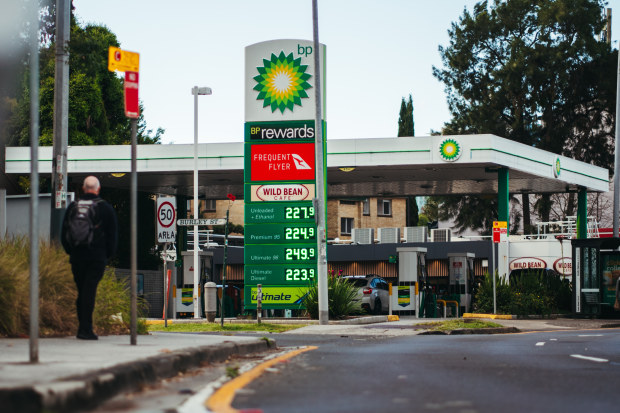Petrol prices drop 30¢ at the bowser as oil slumps

Petrol prices are expected to drop even further across the country as traders remain doubtful that deeper supply cuts by OPEC+ will help stem the rout in oil that pushed prices to five-month lows.
Prices surveyed by Australia’s National Roads and Motorists’ Association showed average regular unleaded prices had fallen almost 30¢ a litre from the top of the cycle in September. The average price for Sydney as of Friday was 181.9¢.
The price fall will take more heat out of inflation growth, which fell to 4.9 per cent in the 12 months to October, and make another Reserve Bank rate rise less likely.

The price of petrol back in September. It’s fallen about 30¢ in some places since then. Dion Georgopoulos
NRMA’s spokesman, Peter Khoury, said petrol prices would continue to fall nationally following a decline in demand for oil after Organisation of Petroleum Exporting Countries and its allies announced it would cut production by 1.1 million barrels a day until the end of the year.
“Obviously, this effect was unintentional and they in a sense overplayed their hand and prices spiked, but oil consumption dropped,” Mr Khoury said. He added that concerns about the strength of Chinese economy was another the reason behind the drop-off in demand and the decline in petrol.
Despite the downward trend across Australia, however, it’s still bad news for Sydneysiders with petrol prices due to climb because the capital city was in the middle of an increase in its 30-day price cycle.
“We expect unfortunately, the cycle is going to work against motorists in Sydney, but it will change depending on where you live,” he added.
In other capital cities, Adelaide was “very cheap” where prices were below 170¢ a litre, while prices in Melbourne, Brisbane and Perth were all falling still at the bowser, thanks to the decline in the oil price.
Mark McKenzie, chief executive of the Australasian Convenience and Petroleum Marketers Association, says motorists can expect the volatility in the petrol price into the new year.

“We’re in a situation where traders seem to have been fairly bearish about the future and there are concerns about what the global economy is actually going to do in early 2024,” he said in an interview.
Oil is hovering near a five-month low as low-conviction trading and mounting concerns about excess supplies leave algorithmic traders calling the shots.
On Friday, the global benchmark brent inched above $US75 a barrel, but is still headed for a seventh-weekly drop – the longest losing streak since 2018.
West Texas Intermediate was near $US70 a barrel after plunging 11 per cent over the past six sessions.
Crude has closed every session lower since last week’s meeting between the Organisation of Petroleum Exporting Countries and its allies and is despite Saudi Arabia announcing that the curbs could be extended beyond March, followed by similar remarks from Russia, Algeria and Kuwait.
There are also concerns about future demand. Chinese consumption is expected to grow by 500,000 barrels a day next year, according to a Bloomberg survey, less than a third of the increase seen in 2023. In the US, many economists see a recession starting next year.
“Clearly when economies slow, demand for oil slows, and so you’re starting to see the futures for the first part of next year,” Mr McKenzie added.
“So we’re currently looking at the January prices being quoted in the markets. It’s lower than you might have otherwise expected because I think the concern about the global economic outlook is overpowering.”
Traders are awaiting Friday’s US non-farm payrolls report due early morning (AEDT) amid mounting speculation that bets on rate cuts by major central banks have gone too far.
Commonwealth Bank’s head of international economics, Joseph Capurso, reiterated this week that the world’s largest economy was headed for recession in 2024, which would sink the Australian dollar back below US60¢.
Bond traders are fully priced for the US Federal Reserve to cut interest rates by May compared with November in Australia.
With Bloomberg
Introducing your Newsfeed
Follow the topics, people and companies that matter to you.
Find out moreRead More
Latest In Commodities
Fetching latest articles